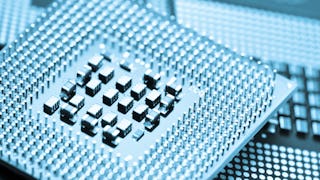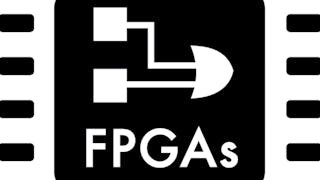Nowadays the complexity of computing systems is skyrocketing. Programmers have to deal with extremely powerful computing systems that take time and considerable skills to be instructed to perform at their best. It is clear that it is not feasible to rely on human intervention to tune a system: conditions change frequently, rapidly, and unpredictably. It would be desirable to have the system automatically adapt to the mutating environment.



FPGA computing systems: A Bird’s Eye View

Instructor: Marco Domenico Santambrogio
Access provided by InternMart, Inc
2,687 already enrolled
(31 reviews)
Recommended experience
What you'll learn
You will learn to give examples of different kinds of reconfigurations
You will able to define reconfigurable computing, to explain the rationale behind an FPGA-based reconfigurable computing system
You will learn how an FPGA can be configured and what a bitstream is used for.
You will learn to design a circuit on an FPGA and how a circuit can be implemented on an FPGA.
Details to know

Add to your LinkedIn profile
11 assignments
See how employees at top companies are mastering in-demand skills


Earn a career certificate
Add this credential to your LinkedIn profile, resume, or CV
Share it on social media and in your performance review

There are 4 modules in this course
Nowadays the complexity of computing systems is skyrocketing. Programmers have to deal with extremely powerful computing systems that take time and considerable skills to be instructed to perform at their best. It is clear that it is not feasible to rely on human intervention to tune a system: conditions change frequently, rapidly, and unpredictably. It would be desirable to have the system automatically adapt to the mutating environment. This module analyzes the stated problem, embraces a radically new approach, and it introduces how software and hardware systems ca ben adjusted during execution. By doing this, we are going to introduce the Field Programmable Gate Arrays (FPGA) technologies and how they can be (re)configured.
What's included
8 videos5 readings5 assignments
Traditionally, computing was classified into General-Purpose Computing performed by a General-Purpose Processor (GPP) and Application-Specific Computing performed by an Application-Specific Integrated Circuit (ASIC). As a trade-off between the two extreme characteristics of GPP and ASIC, reconfigurable computing has combined the advantages of both. On one hand reconfigurable computing can have better performance with respect to a software implementation but paying this in terms of time to implement. On the other hand a reconfigurable device can be used to design a system without requiring the same design time and complexity compared to a full custom solution but being beaten in terms of performance. The main advantage of a reconfigurable system is its high flexibility, while its main disadvantage is the lack of a standard computing model. In this module we are presenting a first definition of reconfigurable computing, describing the rationale behind it and introducing how this field has been influenced by the introduction of the FPGAs.
What's included
5 videos4 readings2 assignments
From the mid-1980s, reconfigurable computing has become a popular field due to the FPGA technology progress. An FPGA is a semiconductor device containing programmable logic components and programmable interconnects but no instruction fetch at run time, that is, FPGAs do not have a program counter. In most FPGAs, the logic components can be programmed to duplicate the functionality of basic logic gates or functional Intellectual Properties (IPs). FPGAs also include memory elements composed of simple flip-flops or more complex blocks of memories. Hence, FPGA has made possible the dynamic execution and configuration of both hardware and software on a single chip. This module provides a detailed description of FPGA technologies starting from a general description down to the discussion on the low-level configuration details of these devices, to the bitstream composition and the description of the configuration registers.
What's included
8 videos3 readings2 assignments
FPGA design tools must provide a design environment based on digital design concepts and components (gates, flip-flops, MUXs, etc.). They must hide the complexities of placement, routing and bitstream generation from the user. This module is not going through these steps in details, an entire course will be needed just for this, but it is important at least to have an idea of what it is happening behind the scene to better understand the complexity of the processes carried out by the tools you are going to use. Within this context, this module guides you through a simple example, which is abstracting the complexity of the underlying FPGA, starting from the description of the circuit you may be willing to implement to the bitstream used to configure the FPGA.
What's included
6 videos1 reading2 assignments
Instructor

Offered by
Why people choose Coursera for their career




Learner reviews
31 reviews
- 5 stars
70.96%
- 4 stars
22.58%
- 3 stars
3.22%
- 2 stars
3.22%
- 1 star
0%
Showing 3 of 31
Reviewed on May 31, 2023
Good course, but all the references are paid articles.To be improved the support materials.
Reviewed on Apr 30, 2022
Pretty much, good introductory course for the folks learning about FPGA's . Hope to see more courses being added up in future on FPGA's reconfigurable computing .
Explore more from Computer Science


University of Colorado Boulder


Politecnico di Milano


Politecnico di Milano


University of Colorado Boulder

Open new doors with Coursera Plus
Unlimited access to 10,000+ world-class courses, hands-on projects, and job-ready certificate programs - all included in your subscription
Advance your career with an online degree
Earn a degree from world-class universities - 100% online
Join over 3,400 global companies that choose Coursera for Business
Upskill your employees to excel in the digital economy

